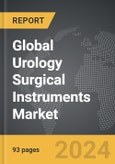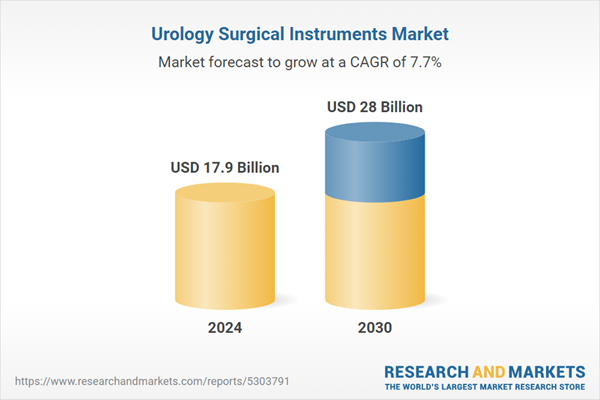Global Urology Surgical Instruments Market - Key Trends & Drivers Summarized
What Are Urology Surgical Instruments, and Why Are They So Crucial in Urological Treatments?
Urology Surgical Instruments are specialized tools designed for the diagnosis, management, and surgical treatment of diseases affecting the urinary tract and male reproductive system. These instruments encompass a wide range of devices, including cystoscopes, resectoscopes, nephroscopes, ureteroscopes, lithotrites, forceps, biopsy needles, stents, catheters, and endoscopes. Urology surgical instruments are used for various procedures, such as diagnosing bladder and kidney conditions, removing kidney stones, treating benign prostatic hyperplasia (BPH), addressing urethral strictures, and conducting prostate and bladder surgeries. These tools are essential for minimally invasive and traditional open surgeries, ensuring precision, safety, and efficacy in urological treatments.The importance of urology surgical instruments lies in their ability to enhance patient care by enabling more precise, safer, and faster procedures. Urological conditions like kidney stones, prostate cancer, bladder tumors, and urinary obstructions require specialized instruments for accurate diagnosis and effective treatment. As the prevalence of these conditions continues to rise, the demand for high-quality surgical instruments that support minimally invasive techniques has grown, improving patient outcomes and reducing recovery times. Urology surgical instruments play a pivotal role in modern urology, supporting a wide range of procedures across hospitals, specialty clinics, and ambulatory surgical centers.
How Are Technological Advancements Shaping the Urology Surgical Instruments Market?
Technological advancements have significantly enhanced the capabilities, precision, and safety of Urology Surgical Instruments, driving innovation in urological procedures. One major development is the improvement in endoscopic instruments, such as flexible ureteroscopes, cystoscopes, and nephroscopes, which offer better visualization, flexibility, and maneuverability within the urinary tract. High-definition digital endoscopes, equipped with fiber optics and advanced imaging technologies, provide clearer views of the internal anatomy, enabling more accurate diagnosis and targeted treatment. These innovations allow urologists to access and treat hard-to-reach areas, improving procedural success rates and minimizing tissue damage.Minimally invasive surgical instruments, such as laparoscopic and robotic-assisted tools, have transformed urological surgery by reducing incision sizes, lowering complication risks, and accelerating patient recovery. Robotic-assisted surgical systems, such as the da Vinci Surgical System, offer enhanced dexterity, precision, and control, making complex procedures like prostatectomy and partial nephrectomy safer and more efficient. The integration of AI and real-time imaging in robotic instruments has further improved decision-making during surgery, providing surgeons with greater accuracy and confidence in complex cases. Additionally, advancements in disposable and single-use instruments have minimized infection risks, streamlined procedures, and reduced costs, making surgeries safer and more accessible.
The development of advanced stone retrieval devices, such as flexible baskets, laser fibers, and lithotrites, has improved the management of urolithiasis. Laser-compatible instruments, including holmium laser fibers and laser lithotrites, are now widely used for breaking down kidney stones during minimally invasive procedures. In the treatment of benign prostatic hyperplasia (BPH), resectoscopes and bipolar electrodes have enhanced the efficiency of transurethral resection and vaporization, reducing bleeding and improving outcomes. These technological advancements are expanding the range and effectiveness of urology surgical instruments, aligning with the growing demand for minimally invasive and patient-centered urological care.
What Are the Emerging Applications of Urology Surgical Instruments Across Different Urological Procedures?
Urology Surgical Instruments are finding expanding applications across various urological procedures, driven by the need for precision, safety, and improved patient outcomes. In the management of kidney stones (urolithiasis), instruments such as flexible ureteroscopes, laser lithotrites, and stone retrieval baskets are essential for endoscopic stone removal, laser lithotripsy, and fragment extraction. These instruments are used to perform minimally invasive procedures, such as ureteroscopy and percutaneous nephrolithotomy (PCNL), allowing for efficient stone treatment with shorter recovery times. In the treatment of benign prostatic hyperplasia (BPH), resectoscopes, bipolar loop electrodes, and laser fibers are commonly used for transurethral resection of the prostate (TURP) and laser vaporization, offering effective symptom relief with minimal bleeding and faster recovery.In addition to stone management and BPH treatment, urology surgical instruments are widely used in oncology for procedures like radical prostatectomy, partial nephrectomy, and bladder tumor resection. Instruments such as laparoscopic scissors, graspers, and endoscopic staplers enable minimally invasive tumor removal, reducing patient morbidity and improving surgical precision. In female urology, instruments like cystoscopes and urethrotomes are used to diagnose and treat conditions such as urinary incontinence, interstitial cystitis, and urethral strictures. Pediatric urology also benefits from miniaturized instruments designed for the treatment of congenital abnormalities and pediatric stone disease, ensuring safe and effective interventions for young patients. The versatility and adaptability of urology surgical instruments across these diverse applications underscore their critical role in addressing a wide range of urological conditions.
What Drives Growth in the Urology Surgical Instruments Market?
The growth in the Urology Surgical Instruments market is driven by several factors, including the rising prevalence of urological conditions, increasing demand for minimally invasive procedures, and advancements in surgical technologies. One of the primary growth drivers is the growing global burden of urological diseases, such as kidney stones, prostate cancer, bladder cancer, and benign prostatic hyperplasia (BPH), which are common conditions affecting millions of people worldwide. As the population ages and risk factors like obesity, diabetes, and sedentary lifestyles become more prevalent, the demand for effective urological treatments has increased, making surgical instruments essential in addressing these conditions.The increasing preference for minimally invasive procedures is another significant driver of market growth. Patients and healthcare providers are opting for laparoscopic, endoscopic, and robotic-assisted surgeries, which offer less pain, shorter hospital stays, faster recovery, and fewer complications compared to traditional open surgery. Urology surgical instruments designed for these minimally invasive techniques, such as flexible scopes, laser fibers, and robotic tools, have become highly sought-after in modern urological care. Advancements in 3D imaging, AI-guided navigation, and robotic systems have further enhanced the precision, safety, and outcomes of urological surgeries, driving the adoption of advanced surgical instruments.
Healthcare reforms and government initiatives aimed at improving urological care access and outcomes have also fueled market growth. Increased healthcare spending, rising awareness of early detection, and expanded insurance coverage for urological procedures have supported the demand for urology surgical instruments in hospitals, specialty clinics, and ambulatory surgical centers. Additionally, the growing adoption of disposable and single-use instruments has contributed to market growth by reducing infection risks and improving procedure efficiency. With continuous innovations in instrument design, imaging integration, and robotic-assisted surgery, the urology surgical instruments market is poised for strong growth, driven by the global demand for safer, more effective, and patient-centric urological care.
Report Scope
The report analyzes the Urology Surgical Instruments market, presented in terms of units. The analysis covers the key segments and geographic regions outlined below.Segments: Product (Consumables & Accessories, Urology Endoscopes, Endovision Systems, Peripheral Systems); Application (Chronic Kidney Diseases, Urinary Stones, Benign Prostatic Hyperplasia, Urinary Incontinence & Pelvic Organ Prolapse, Other Applications).
Geographic Regions/Countries: World; United States; Canada; Japan; China; Europe (France; Germany; Italy; United Kingdom; and Rest of Europe); Asia-Pacific; Rest of World.
Key Insights:
- Market Growth: Understand the significant growth trajectory of the Consumables & Accessories segment, which is expected to reach US$13.5 Billion by 2030 with a CAGR of a 8.2%. The Urology Endoscopes segment is also set to grow at 7.5% CAGR over the analysis period.
- Regional Analysis: Gain insights into the U.S. market, valued at $5.0 Billion in 2024, and China, forecasted to grow at an impressive 7.1% CAGR to reach $4.3 Billion by 2030. Discover growth trends in other key regions, including Japan, Canada, Germany, and the Asia-Pacific.
Why You Should Buy This Report:
- Detailed Market Analysis: Access a thorough analysis of the Global Urology Surgical Instruments Market, covering all major geographic regions and market segments.
- Competitive Insights: Get an overview of the competitive landscape, including the market presence of major players across different geographies.
- Future Trends and Drivers: Understand the key trends and drivers shaping the future of the Global Urology Surgical Instruments Market.
- Actionable Insights: Benefit from actionable insights that can help you identify new revenue opportunities and make strategic business decisions.
Key Questions Answered:
- How is the Global Urology Surgical Instruments Market expected to evolve by 2030?
- What are the main drivers and restraints affecting the market?
- Which market segments will grow the most over the forecast period?
- How will market shares for different regions and segments change by 2030?
- Who are the leading players in the market, and what are their prospects?
Report Features:
- Comprehensive Market Data: Independent analysis of annual sales and market forecasts in US$ Million from 2024 to 2030.
- In-Depth Regional Analysis: Detailed insights into key markets, including the U.S., China, Japan, Canada, Europe, Asia-Pacific, Latin America, Middle East, and Africa.
- Company Profiles: Coverage of players such as Boston Scientific Corporation, Coloplast A/S, Conmed Corporation, Cook Medical Incorporated, Coopersurgical, Inc. (A Subsidiary of The Cooper Companies, Inc.) and more.
- Complimentary Updates: Receive free report updates for one year to keep you informed of the latest market developments.
Some of the 42 companies featured in this Urology Surgical Instruments market report include:
- Boston Scientific Corporation
- Coloplast A/S
- Conmed Corporation
- Cook Medical Incorporated
- Coopersurgical, Inc. (A Subsidiary of The Cooper Companies, Inc.)
- Karl Storz GmbH & Co. Kg
- Medtronic PLC
- Olympus Corporation
- Richard Wolf GmbH
Tariff Impact Analysis: Key Insights for 2025
Global tariff negotiations across 180+ countries are reshaping supply chains, costs, and competitiveness. This report reflects the latest developments as of April 2025 and incorporates forward-looking insights into the market outlook.The analysts continuously track trade developments worldwide, drawing insights from leading global economists and over 200 industry and policy institutions, including think tanks, trade organizations, and national economic advisory bodies. This intelligence is integrated into forecasting models to provide timely, data-driven analysis of emerging risks and opportunities.
What’s Included in This Edition:
- Tariff-adjusted market forecasts by region and segment
- Analysis of cost and supply chain implications by sourcing and trade exposure
- Strategic insights into geographic shifts
Buyers receive a free July 2025 update with:
- Finalized tariff impacts and new trade agreement effects
- Updated projections reflecting global sourcing and cost shifts
- Expanded country-specific coverage across the industry
Table of Contents
Companies Mentioned (Partial List)
A selection of companies mentioned in this report includes, but is not limited to:
- Boston Scientific Corporation
- Coloplast A/S
- Conmed Corporation
- Cook Medical Incorporated
- Coopersurgical, Inc. (A Subsidiary of The Cooper Companies, Inc.)
- Karl Storz GmbH & Co. Kg
- Medtronic PLC
- Olympus Corporation
- Richard Wolf GmbH
Table Information
| Report Attribute | Details |
|---|---|
| No. of Pages | 93 |
| Published | April 2025 |
| Forecast Period | 2024 - 2030 |
| Estimated Market Value ( USD | $ 17.9 Billion |
| Forecasted Market Value ( USD | $ 28 Billion |
| Compound Annual Growth Rate | 7.7% |
| Regions Covered | Global |









